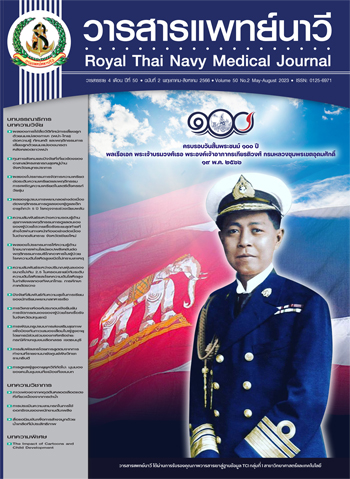Confirmatory Factor Analysis of Self-management for Chronic Disease Patients at Pathum Thani Province
Main Article Content
Abstract
The purpose of this analytical research was to study the confirmatory factor of self-management for chronic disease patients. The sample consisted of 230 persons with diabetes and/or hypertension in Pathum Thani province. The data were collected by using self-report questionnaires with 4-point rating scale. The content validity was determined with the validity index = 0.92 and coefficient Cronbach’s alpha = 0.77. The quantitative data was analyzed by using descriptive statistics and the component statistics was analyzed by using Confirmatory Factor Analysis.
The research findings showed that there were 4 components of self-management of patients with chronic disease from the literature review and content analysis namely: 1) Self-health care behaviors during exacerbation 2) Self-health monitoring behaviors 3) Self-health promotion behavior, and 4) General health management behavior. When analyzed by Exploratory Factor Analysis (EFA), the 4 components had Eigen values greater than 1% of valance cumulative 67.94 and Confirmatory Factor Analysis by the test of congruence of the empirical data with the conceptual framework showed the following results: (c2 (df = 79, n = 230) = 318.470, CFI = .901, TLI = .900, RMSEA = .056, SRMR = .065). This research points out that explicit knowledge of confirmatory factors for self-management for chronic disease patients which is consistent with the community hospital context is a quality tool that can be applied to develop health promotion program for chronic disease patients in Thailand.
Article Details

This work is licensed under a Creative Commons Attribution-NonCommercial-NoDerivatives 4.0 International License.
References
World Health Organization. Hypertension. [internet]. [cited 2021 August 25]. Available from: https://www.who.int/news-room/fact-sheets/detail/hypertension.
American Diabetes Association. Standards of medical care in diabetes--2016. Diabetes Care 2016;39(Suppl1): S13-S22.
Thai Hypertension Society. Thai guidelines on the treatment of hypertension. Chiang Mai: Trick Think; 2019. (in Thai).
Divisions of Non Communication Disease, Ministry of Public Health. Non communication disease data. [internet]. [cited 2021 August 25]. Available from: http://www.thaincd.com/2016/mission/ documents detail.php?id=13653&tid=32&gid=1-020. (in Thai).
Adler AJ, Prabhakaran D, Bovet P, Kazi DS, Mancia G, Mungal-Singh V, et al. Reducing cardiovascular mortality through prevention and management of raised blood pressure: a World Heart Federation roadmap. Global Heart 2015;10(2):111-22.
Jordan EJ, Buchbinder R, Briggs MA, Elsworth RG, Busija L, Batterham R, et al. The health literacy management scale (HeLMS): a measure of an individual’s capacity to seek, understand and use health information within the healthcare setting. Patient Education and Counseling 2013;91(2):228-35.
Stithyudhakorn S,Yunidhand J, Phaokuntarakorn W, The effect of self- management with family participation program on psychotic symptoms of patient with chronic schizophrenia. Royal Thai Navy Medical Journal 2021;48(1):1-22. (in Thai).
Andersen B, DeRubeis R, Berman. B, Gruman J, Champion V, Massie M, et.al. Screening, assessment, and care of anxiety and dpressive symptoms in adults with cancer: an American Society of clinical oncology guideline adaptation. J Clin Oncol 2014;32(15):1605-19.
Phakpiyawat D, Hoontrakul S, Nimit-arnun N, The effect of self- management program related to medication adherence in uncontrallable hypertensive patients at a private clinic in Pathum Thani province. Royal Thai Navy Medical Journal 2017;45(2):377-98. (in Thai).
Creer LT. Self-management of chronic illness. In: Boekaerts M, Printrich PR, Zeidner M, editors. Hand book of self-regulation. San Diego, CA: Academic Press; 2000. p.601-29.
Riegel B, Barbaranelli C, Sethares KA, Daus M, Moser DK, Miller JL, et al. Development and initial testing of the self- care of chronic illness inventory. J Adv Nurs 2018;74(10):2465-76.
Hair JF, Black WC, Babin BJ, Anderson RE, ham Ronald L. Multivariate data analysis. 7th ed. New Jersy: Prentice Hall; 2010.
Soper DS. A-priori sample size calculator for structural equation models. [Internet]. [cited 2022 August 1]. Available from: http://wwwdanielsopercom/statcalc.
Gupta K, Attri JP, Singh A, Kaur H, Kaur G. Basic concepts for sample size calculation: critical step for any clinical trials!. Saudi J Anaesth 2016;10(3):328-31.
Burns N. Grove SK. The practice of nursing research, conduct, critique, and utilization. 4th ed. Philadelphia: W.B. Saunders; 2001.
DeVellis RF. Scale development: theory and applications. Los Angeles: SAGE; 2016.
Comrey AL, Lee HB. A first course in factor analysis. 2nd ed. New York: Routledge; 1992.
Mukaka MM. Statistics corner: a guide to appropriate use of correlation coefficient in medical research. Malawi Medical Journal 2012;24(3):69-71.
Kline RB. Methodology in the social sciences: principles and practice of structural equation modeling. 4th ed. New York: Guilford Press; 2011.
Hair JF, Black WC, Babin BJ, Anderson RE. Multivariate data analysis. Hampshire: Cengage Learning; 2019.
Little TD. Longitudinal structural equation modeling. New York: Guilford Press; 2013.
Farley H. Promoting self-efficacy in patients with chronic disease beyond traditional education: a literature review. Nursing Open 2020;7:30- 41.
Han TC, Lin HS, Chen CM. Association between chronic disease self-management, health status, and quality of life in Taiwanese adults with chronic illnesses. Healthcare (Basel) 2022;10(4):609.

